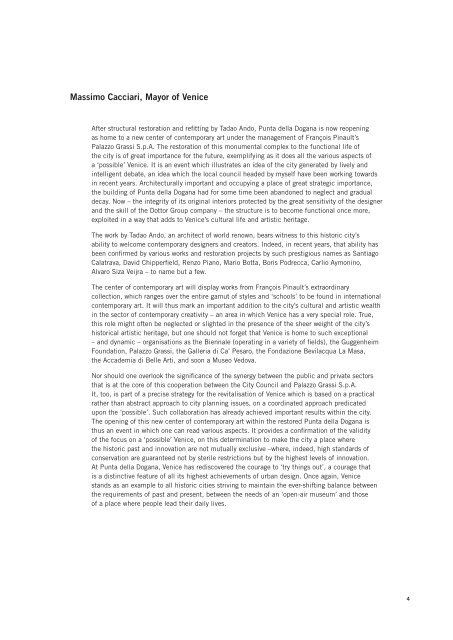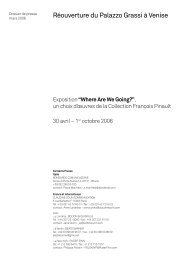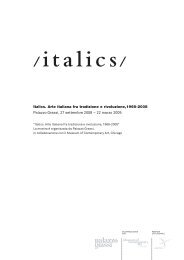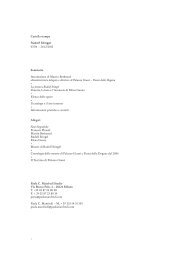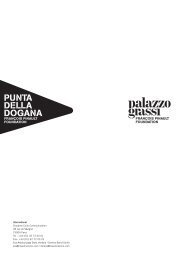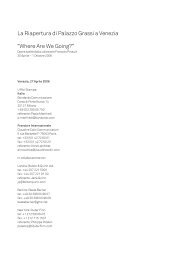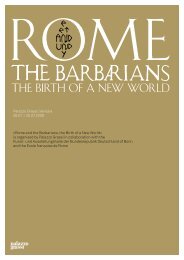Press Kit (pdf file, 490 Kb) - Palazzo Grassi
Press Kit (pdf file, 490 Kb) - Palazzo Grassi
Press Kit (pdf file, 490 Kb) - Palazzo Grassi
You also want an ePaper? Increase the reach of your titles
YUMPU automatically turns print PDFs into web optimized ePapers that Google loves.
Massimo Cacciari, Mayor of Venice<br />
After structural restoration and refitting by Tadao Ando, Punta della Dogana is now reopening<br />
as home to a new center of contemporary art under the management of François Pinault’s<br />
<strong>Palazzo</strong> <strong>Grassi</strong> S.p.A. The restoration of this monumental complex to the functional life of<br />
the city is of great importance for the future, exemplifying as it does all the various aspects of<br />
a ‘possible’ Venice. It is an event which illustrates an idea of the city generated by lively and<br />
intelligent debate, an idea which the local council headed by myself have been working towards<br />
in recent years. Architecturally important and occupying a place of great strategic importance,<br />
the building of Punta della Dogana had for some time been abandoned to neglect and gradual<br />
decay. Now – the integrity of its original interiors protected by the great sensitivity of the designer<br />
and the skill of the Dottor Group company – the structure is to become functional once more,<br />
exploited in a way that adds to Venice’s cultural life and artistic heritage.<br />
The work by Tadao Ando, an architect of world renown, bears witness to this historic city’s<br />
ability to welcome contemporary designers and creators. Indeed, in recent years, that ability has<br />
been confirmed by various works and restoration projects by such prestigious names as Santiago<br />
Calatrava, David Chipperfield, Renzo Piano, Mario Botta, Boris Podrecca, Carlio Aymonino,<br />
Alvaro Siza Veijra – to name but a few.<br />
The center of contemporary art will display works from François Pinault’s extraordinary<br />
collection, which ranges over the entire gamut of styles and ‘schools’ to be found in international<br />
contemporary art. It will thus mark an important addition to the city’s cultural and artistic wealth<br />
in the sector of contemporary creativity – an area in which Venice has a very special role. True,<br />
this role might often be neglected or slighted in the presence of the sheer weight of the city’s<br />
historical artistic heritage, but one should not forget that Venice is home to such exceptional<br />
– and dynamic – organisations as the Biennale (operating in a variety of fields), the Guggenheim<br />
Foundation, <strong>Palazzo</strong> <strong>Grassi</strong>, the Galleria di Ca’ Pesaro, the Fondazione Bevilacqua La Masa,<br />
the Accademia di Belle Arti, and soon a Museo Vedova.<br />
Nor should one overlook the significance of the synergy between the public and private sectors<br />
that is at the core of this cooperation between the City Council and <strong>Palazzo</strong> <strong>Grassi</strong> S.p.A.<br />
It, too, is part of a precise strategy for the revitalisation of Venice which is based on a practical<br />
rather than abstract approach to city planning issues, on a coordinated approach predicated<br />
upon the ‘possible’. Such collaboration has already achieved important results within the city.<br />
The opening of this new center of contemporary art within the restored Punta della Dogana is<br />
thus an event in which one can read various aspects. It provides a confirmation of the validity<br />
of the focus on a ‘possible’ Venice, on this determination to make the city a place where<br />
the historic past and innovation are not mutually exclusive –where, indeed, high standards of<br />
conservation are guaranteed not by sterile restrictions but by the highest levels of innovation.<br />
At Punta della Dogana, Venice has rediscovered the courage to ‘try things out’, a courage that<br />
is a distinctive feature of all its highest achievements of urban design. Once again, Venice<br />
stands as an example to all historic cities striving to maintain the ever-shifting balance between<br />
the requirements of past and present, between the needs of an ‘open-air museum’ and those<br />
of a place where people lead their daily lives.<br />
4


